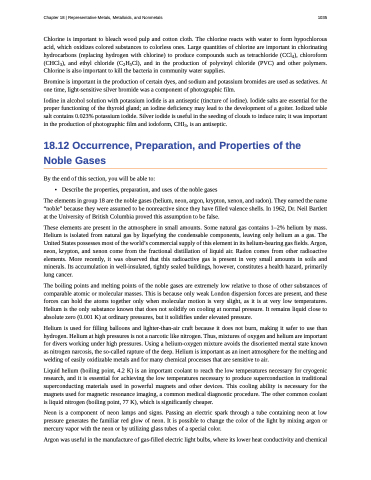Page 1045 - Chemistry--atom first
P. 1045
Chapter 18 | Representative Metals, Metalloids, and Nonmetals 1035
Chlorine is important to bleach wood pulp and cotton cloth. The chlorine reacts with water to form hypochlorous acid, which oxidizes colored substances to colorless ones. Large quantities of chlorine are important in chlorinating hydrocarbons (replacing hydrogen with chlorine) to produce compounds such as tetrachloride (CCl4), chloroform (CHCl3), and ethyl chloride (C2H5Cl), and in the production of polyvinyl chloride (PVC) and other polymers. Chlorine is also important to kill the bacteria in community water supplies.
Bromine is important in the production of certain dyes, and sodium and potassium bromides are used as sedatives. At one time, light-sensitive silver bromide was a component of photographic film.
Iodine in alcohol solution with potassium iodide is an antiseptic (tincture of iodine). Iodide salts are essential for the proper functioning of the thyroid gland; an iodine deficiency may lead to the development of a goiter. Iodized table salt contains 0.023% potassium iodide. Silver iodide is useful in the seeding of clouds to induce rain; it was important in the production of photographic film and iodoform, CHI3, is an antiseptic.
18.12 Occurrence, Preparation, and Properties of the Noble Gases
By the end of this section, you will be able to:
• Describe the properties, preparation, and uses of the noble gases
The elements in group 18 are the noble gases (helium, neon, argon, krypton, xenon, and radon). They earned the name “noble” because they were assumed to be nonreactive since they have filled valence shells. In 1962, Dr. Neil Bartlett at the University of British Columbia proved this assumption to be false.
These elements are present in the atmosphere in small amounts. Some natural gas contains 1–2% helium by mass. Helium is isolated from natural gas by liquefying the condensable components, leaving only helium as a gas. The United States possesses most of the world’s commercial supply of this element in its helium-bearing gas fields. Argon, neon, krypton, and xenon come from the fractional distillation of liquid air. Radon comes from other radioactive elements. More recently, it was observed that this radioactive gas is present in very small amounts in soils and minerals. Its accumulation in well-insulated, tightly sealed buildings, however, constitutes a health hazard, primarily lung cancer.
The boiling points and melting points of the noble gases are extremely low relative to those of other substances of comparable atomic or molecular masses. This is because only weak London dispersion forces are present, and these forces can hold the atoms together only when molecular motion is very slight, as it is at very low temperatures. Helium is the only substance known that does not solidify on cooling at normal pressure. It remains liquid close to absolute zero (0.001 K) at ordinary pressures, but it solidifies under elevated pressure.
Helium is used for filling balloons and lighter-than-air craft because it does not burn, making it safer to use than hydrogen. Helium at high pressures is not a narcotic like nitrogen. Thus, mixtures of oxygen and helium are important for divers working under high pressures. Using a helium-oxygen mixture avoids the disoriented mental state known as nitrogen narcosis, the so-called rapture of the deep. Helium is important as an inert atmosphere for the melting and welding of easily oxidizable metals and for many chemical processes that are sensitive to air.
Liquid helium (boiling point, 4.2 K) is an important coolant to reach the low temperatures necessary for cryogenic research, and it is essential for achieving the low temperatures necessary to produce superconduction in traditional superconducting materials used in powerful magnets and other devices. This cooling ability is necessary for the magnets used for magnetic resonance imaging, a common medical diagnostic procedure. The other common coolant is liquid nitrogen (boiling point, 77 K), which is significantly cheaper.
Neon is a component of neon lamps and signs. Passing an electric spark through a tube containing neon at low pressure generates the familiar red glow of neon. It is possible to change the color of the light by mixing argon or mercury vapor with the neon or by utilizing glass tubes of a special color.
Argon was useful in the manufacture of gas-filled electric light bulbs, where its lower heat conductivity and chemical


